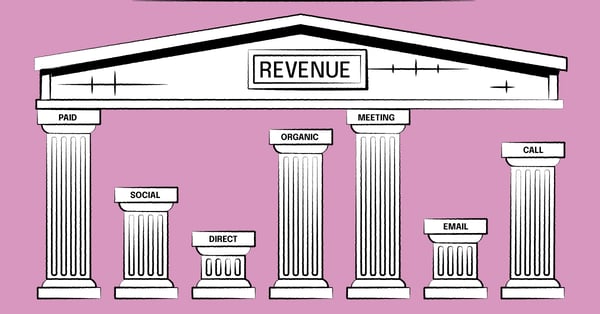With the average buying journey growing more complex, businesses turn to multi-touch attribution to make sense of it all.
Go-to-market leaders need details on critical aspects such as ads clicked, blogs read, and reviews compared when looking to optimize different activities. Multi-touch attribution plays a big role here.
What is multi-touch attribution (MTA)?
Multi-touch attribution is a marketing concept of determining the value of customer journey touchpoints in generating a conversion event. It assigns value or credit to various customer interactions with a brand that leads to the desired outcome.
Marketing attribution software helps companies determine how customer actions or touchpoints contribute to their success. It tracks recordable customer touchpoints for customer journey analytics to help marketers make the best possible decisions.
A conversion event can be a customer signing up for a free trial, booking a demo request, or making the actual purchase – or all, as some multi-touch attribution tools allow attribution by pipeline stage.
Multi-touch attribution modeling works with data gathered from touchpoints in a buyer’s journey. Marketers can use this to determine the marketing channels or campaigns the conversion should be attributed to and act with different multi-touch models.
Different multi-touch models accredit touchpoints differently to accommodate a particular business model. This enables marketers to optimize their efforts and acquire new customers more effectively.
Why is multi-touch attribution important?
But why is this important to go-to-market teams? For two broad reasons:
- Provides clarity in the customer journey. Multi-touch attribution modeling relies on collecting as much customer journey data as possible. This, in turn, offers critical information about customer behavior and activities throughout the buying journey. It helps account for key metrics such as how long it takes for leads to convert, time spent at different journey stages, touchpoints with your brand, content consumed, and so on.
- Helps measure the performance of go-to-market strategy. After assigning credit to the touchpoints that convert, attribution’s modeling helps see what activities generate pipeline and revenue. This allows marketers to understand the efforts to be scaled, optimized, or stopped altogether. However, how you accredit the activities depends on your multi-touch model.
Multi-channel vs. multi-touch attribution
Multi-channel attribution (MCA) and multi-touch attribution are often used interchangeably but differ in the level of analysis. Multi-touch attribution credits every touch from an ad campaign and blog post to an email cadence. Multi-channel attribution credits are based only on the channels touched, such as paid, organic, email, and social.

For a marketer, the difference between these two relates to the level of touchpoint analysis. Multi-channel attribution provides a high-level view of a channel’s overall performance. In contrast, multi-touch attribution helps optimize performance at all levels.
How is MTA different from single, first, and last-touch attribution?
Businesses often use single-touch attribution on their CRM or marketing automation platform. Single-touch, first-touch, and last-touch attribution all provide insight into the touchpoint that helped acquire or convert a lead.
So how is multi-touch attribution different from these models?
Single-touch models only count one touch in the buying journey, usually the first or last, known as first-touch and last-touch attributions, respectively. Anything in between doesn’t count toward conversions.
On the other hand, multi-touch attribution models credit all touches and distribute them according to the chosen model. Here’s a simple example to illustrate the difference between first-touch and last-touch compared to multi-touch attribution modeling.
Before converting, a customer goes through three marketing touchpoints: a Google Ads click, a LinkedIn conversation ad, and a G2 product comparison ad before requesting a demo. First-touch attribution credits only Google Ads, and last-touch G2 comparison. However, a multi-touch model distributes credits to all three in some way.
Is one better than the other? Well, some attribution is better than none, as it gives you data insights into how your go-to-market activities are performing.
Simply put, while single-touch models are easy to set up and offer revenue leaders a glimpse into the touchpoints converting leads, they paint only a fragment of the overall picture.
This incoherent overview makes it difficult to act on the data. Do you then focus only on the last touched ad or channel and ignore the other touchpoints? Multi-touch models offer you a clearer picture of the customer journey – which efforts affect a deal and which don’t.
Multi-touch attribution models and methods
Unlike single-touch models that credit just one touch, a multi-touch model assigns credits differently.
MTA lets you choose different models depending on your needs. For example, you might give more weight to the first and last touches and less weight to the ones in between in a U-shaped model. Alternatively, you can assign equal credit to all touchpoints in the linear model.
The attribution model you use depends on your business model and user insights. In fact, using more than one multi-touch attribution model can help make better decisions. Here are the most common multi-touch attribution models.
1. Linear model
The linear model is the simplest of the multi-touch attribution models because it distributes credit evenly across all touches before conversion. If customers have four touchpoints before the conversion event, each point receives 25% credit.
Linear models help avoid the arbitrary process of selecting the more critical touches in the sales funnel and give them all equal credit. This is also its main limitation. When you focus on acquisition, you need to give more weight to the first touch, which the linear model doesn’t do.
2. U-shaped model
The U-shaped attribution model tracks every touchpoint but assigns 40% to the anonymous first touch and 40% to lead conversion. The remaining touchpoints are split 20%. The U-shaped model emphasizes the contacts that result in acquisition and meeting conversion goals.
3. W-shaped model
Like the U-shaped model, the W-shaped model emphasizes the first touch, lead conversion touch, and opportunity creation touchpoint. These three touchpoints are each credited with 30%, and the last 10% is divided evenly among the remaining touchpoints.
The key benefit of the W-shaped attribution model is highlighting the top three marketing attribution transitions in the customer journey. However, this added complexity can make modeling more difficult to set up, especially with inadequate tracking to identify those touches.
4. Time-decay model
The time-decay attribution model gives more weight to the touchpoints closest to conversion. The closer the conversion event gets, the more influence these touchpoints have on conversion.
Time decay prioritizes touches that drive conversions over those that sit on top-of-funnel. This is especially helpful for businesses with long sales cycles. However, the time-decay model underestimates the value of top-of-the-funnel marketing efforts, which is critical to acquiring new customers.
5. Full path model
A full path model accounts for all touchpoints in the customer journey up to the point of purchase – and not just a conversion event. As a result, full path attribution modeling provides an accurate, start-to-finish overview of all touchpoints in the customer journey. A full path model receives credit with all other models but is stretched across the sales cycle.
Full path modeling is most relevant for B2B marketing on existing opportunities. This presents the additional challenge of data reconciliation for the sales teams.
6. Z-shaped model
The Z-shaped attribution is unique to B2B and typically has four main touches: the first, lead creation (MQL), opportunity creation (SQL), and the last touch. Each gets 22.5% of the credit, and the remaining 10% is split equally among the remaining touchpoints.
Z-shaped attribution highlights four critical pipeline transitions that marketing has in the B2B sales cycle. However, it can be tough to set up a full path model that spans the long B2B cycle.
7. Custom model
Suppose you want to go for a custom solution. In this case, a data scientist can build an attribution model that best fits the customer journey specific to your buying process. You can decide which touchpoints (and relevant pipeline stages, if any) get what percentage of the credit.
A custom model is the most difficult and resource-intensive model to create, maintain, and use. By definition, every custom model carries an inherent bias toward what you feel should be given the most credit, even if that may not be the best for your business.
How to implement multi-touch attribution
To get multi-touch attribution off the ground, you only have two options: build your attribution modeling in-house or buy an off-the-shelf tool, each with its pros and disadvantages.
Although MTA lets you dictate exactly the reports you receive, it’s resource and time-consuming to set up, especially for development teams. It takes time and resources away from other business-critical tasks.
Typically, building a multi-touch attribution tool from scratch benefits larger businesses or enterprises. Even then, you shouldn’t ignore off-the-shelf tools. Most of these tools are highly customizable, allowing access to raw data once captured and transformed, making these tools attractive to businesses across the board.
Pro Tip: Pay attention to company-specific requirements. For example, if your customers are predominantly mobile, your solution needs to be tailored accordingly. Likewise, in the B2B space, you need a specialized B2B attribution solution that accounts for multi-stakeholder and longer B2B buying cycles.
Keep these three critical aspects of multi-touch attribution in mind when defining the project internally or comparing multi-touch attribution vendors.
- Track: You need to track data from the entire buyer journey. This includes the data that resides in each of the tools used, including marketing automation, ad platforms, CRM, and so on, as well as online behavioral tracking.
- Transform and model: Next, you also need to process this data to make sure it’s clean (connected, standardized, and deduplicated) so that you can apply the attribution modeling you want or need.
- Visualize: Finally, you need a decent way to operationalize and visualize the data. You need to present this data easily digestible and actionable through reports and charts.
Combining multi-touch attribution and marketing mix modeling (MMM)
Multi-touch attribution is not the only data modeling available to measure performance. Marketers have long used marketing mix modeling (MMM) to gain insight into their efforts.
Marketing mix modeling uses aggregated data from the following four elements:
- Product
- Price
- Location
- Advertising
Using regression analysis, data from these four items (the independent variables) are plotted against sales (the dependent variable) to show the relationship (the reading impact) that each item has on sales.
MMM can encompass a broader range of data by working with aggregated data, including offline and non-digital ads. However, the results only benefit at a higher level and not with the granularity you get with attribution.
The good news is that using both methods is not inconceivable.
Benefits of multi-touch attribution
What are the benefits of multi-touch attribution for go-to-market teams? Analytics has almost endless use cases of attribution. But here are some of the pain points multi-touch attribution helps solve:
- Connect your ad spend to the generated revenue and pipeline. When you know what works and what doesn’t and identify channels and campaigns not impacting the buying journey, you need to scrap or tweak them in some way with better targeting, bidding, and so on.
- Map end-to-end customer journey for a holistic view of your sales cycle. Multi-touch attribution collects data on all recordable touches and gives users a much clearer picture of what’s happening in the buyer’s journey.
- Compare channel and campaign performance using the same benchmark. Multi-touch attribution connects sales intelligence activities to the sales pipeline and revenue generated, helping compare different activities from content and ads to sales efforts.
- Identify where quality leads are acquired. MTA connects the first touch to events further down the pipeline and helps track the performance of acquisition channels in generating high-quality leads that continue down the pipeline even after the first conversion event.
- Remove data silos in the tech stack. Multi-touch attribution also offers other significant advantages at the data level. With MTA, you can collect and process data from across the go-to-market tech stack and cleanse and centralize this data that otherwise sits siloed in each of the tools.
Multi-touch attribution challenges
As with any solution, multi-touch attribution is not without its challenges. It can be challenging to implement for many reasons:
- Multi-touch attribution needs data, and this data needs to be clean. Considering gathering data from across the customer journey is no easy task; you need multiple integrations with tools and site tracking. Further steps include data cleaning, joining, standardizing, and de-duplicating for accurate data modeling. An off-the-shelf tool with custom integrations goes a long way in solving this, but the process can still be lengthy.
- Multi-touch attribution requires resources and an understanding of how best to use it. While MTA data can reinforce long-held “gut feelings” about what works and doesn’t, the opposite is true. It can identify poorly performing channels and campaigns that appear to be performing well. Teams need to be prepared and incorporate the power of data into their decision-making.
- Multi-touch attribution doesn’t provide an overview of every single factor in a purchase decision. After all, it’s practically impossible to do so. For example, a buyer’s private conversations and the impact of “dark social” simply cannot be accounted for.
For this reason, attribution insights are about correlation and not causation. Although data drives modeling, understanding and executing it is still an art.
Which touchpoints do you care about?
In summary, multi-touch attribution tracks and credits all recordable touches in the customer journey. This helps organizations move away from the narrower details of single-touch attribution or no attribution analysis.
Businesses can then choose the model that best fits their unique go-to-market setup. However, this is not without its challenges. Setting up the right multi-touch attribution modeling takes time to implement and operationally deploy technically.
Still, you can’t undermine MTA’s value. It offers unprecedented information about the customer journey, showing the activities that work and don’t, as well as what needs to be scaled or discarded.
Combine your multi-touch attribution models and performance marketing efforts to make your advertising campaigns more data-driven and efficient.










